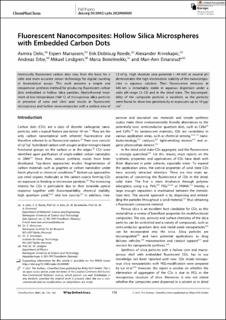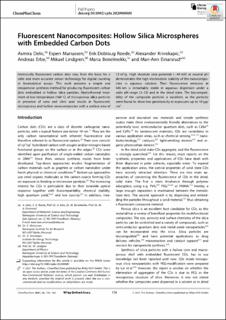| dc.contributor.author | Delic, Asmira | |
| dc.contributor.author | Mariussen, Espen | |
| dc.contributor.author | Roede, Erik Dobloug | |
| dc.contributor.author | Krivokapic, Alexander | |
| dc.contributor.author | Erbe, Andreas | |
| dc.contributor.author | Lindgren, Mikael | |
| dc.contributor.author | Benelmekki, Maria | |
| dc.contributor.author | Einarsrud, Mari-Ann | |
| dc.date.accessioned | 2022-04-28T11:32:03Z | |
| dc.date.available | 2022-04-28T11:32:03Z | |
| dc.date.created | 2021-01-22T14:16:09Z | |
| dc.date.issued | 2021 | |
| dc.identifier.citation | ChemPlusChem. 2021, 86 (1), 176-183. | en_US |
| dc.identifier.issn | 2192-6506 | |
| dc.identifier.uri | https://hdl.handle.net/11250/2993185 | |
| dc.description.abstract | Intrinsically fluorescent carbon dots may form the basis for a safer and more accurate sensor technology for digital counting in bioanalytical assays. This work presents a simple and inexpensive synthesis method for producing fluorescent carbon dots embedded in hollow silica particles. Hydrothermal treatment at low temperature (160 °C) of microporous silica particles in presence of urea and citric acid results in fluorescent, microporous and hollow nanocomposites with a surface area of 12 m2/g. High absolute zeta potential (−44 mV) at neutral pH demonstrates the high electrosteric stability of the nanocomposites in aqueous solution. Their fluorescence emission at 445 nm is remarkably stable in aqueous dispersion under a wide pH range (3–12) and in the dried state. The biocompatibility of the composite particles is excellent, as the particles were found to show low genotoxicity at exposures up to 10 μg/cm2. | en_US |
| dc.language.iso | eng | en_US |
| dc.rights | Attribution-NonCommercial-NoDerivatives 4.0 Internasjonal | * |
| dc.rights.uri | http://creativecommons.org/licenses/by-nc-nd/4.0/deed.no | * |
| dc.title | Fluorescent Nanocomposites: Hollow Silica Microspheres with Embedded Carbon Dots | en_US |
| dc.title.alternative | Fluorescent Nanocomposites: Hollow Silica Microspheres with Embedded Carbon Dots | en_US |
| dc.type | Peer reviewed | en_US |
| dc.type | Journal article | en_US |
| dc.description.version | publishedVersion | en_US |
| dc.rights.holder | © 2021 The Authors. | en_US |
| dc.source.pagenumber | 176-183 | en_US |
| dc.source.volume | 86 | en_US |
| dc.source.journal | ChemPlusChem | en_US |
| dc.source.issue | 1 | en_US |
| dc.identifier.doi | 10.1002/cplu.202000801 | |
| dc.identifier.cristin | 1877243 | |
| dc.relation.project | NILU - Norsk institutt for luftforskning: 117101 | en_US |
| dc.relation.project | Norges forskningsråd: 254995 | en_US |
| dc.relation.project | Norges forskningsråd: 197405 | en_US |
| dc.relation.project | Norges forskningsråd: 245963 | en_US |
| cristin.ispublished | true | |
| cristin.fulltext | original | |
| cristin.fulltext | original | |
| cristin.qualitycode | 1 | |


